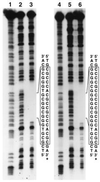Design of polydactyl zinc-finger proteins for unique addressing within complex genomes
- PMID: 9159105
- PMCID: PMC20811
- DOI: 10.1073/pnas.94.11.5525
Design of polydactyl zinc-finger proteins for unique addressing within complex genomes
Abstract
Zinc-finger proteins of the Cys2-His2 type represent a class of malleable DNA-binding proteins that may be selected to bind diverse sequences. Typically, zinc-finger proteins containing three zinc-finger domains, like the murine transcription factor Zif268 and the human transcription factor Sp1, bind nine contiguous base pairs. To create a class of proteins that would be generally applicable to target unique sites within complex genomes, we have utilized structure-based modeling to design a polypeptide linker that fuses two three-finger proteins. Two six-fingered proteins were created and demonstrated to bind 18 contiguous bp of DNA in a sequence-specific fashion. Expression of these proteins as fusions to activation or repression domains allows transcription to be specifically up- or down-modulated within human cells. Polydactyl zinc-finger proteins should be broadly applicable as genome-specific transcriptional switches in gene therapy strategies and the development of novel transgenic plants and animals.
Figures




References
Publication types
MeSH terms
Substances
Grants and funding
LinkOut - more resources
Full Text Sources
Other Literature Sources

